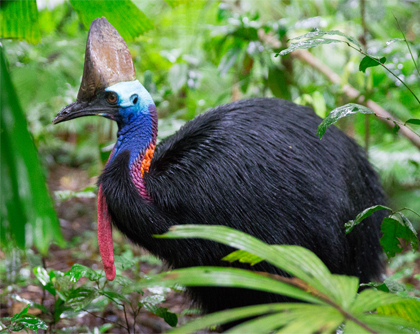A Casque of Thousands
A recent study examined the internal anatomy of a cassowary casque in an attempt to better understand its evolution and ecological function.The Southern Cassowary (Casuarius casuarius) is one of Australia’s most distinctive birds yet surprisingly, there is still much to learn about this majestic creature. This is of particular concern given the important role that cassowaries play in maintaining tropical rainforest diversity and structure.
 Photographer: Liz Gallie
Photographer: Liz Gallie

Photographer Marty Stringer
Cassowary casques
Cassowaries are one of only a handful of animals to have a casque, the ‘helmet-like’ structure that sits atop their heads. Made of keratin, the key structural material found in hair and nails, it is a defining feature of the species. However, despite its prominence, we don’t really know why these helmet-like structures exist.
A research team headed by Dr Darren Naish from the University of Southampton has provided new anatomical information about the cassowary’s casque that is helping to address this important knowledge gap. Dr Naish’s team has, for the first time, described in detail the anatomy of the casque, offering ideas as to its evolution and function.
Six hypotheses, some anecdotal, have previously been proposed to explain the casque’s presence. Dr Naish’s team evaluated each hypothesis using the anatomical information they obtained dissecting a cassowary skull (see Table 1).
Based on their observations, the researchers concluded that the most likely functions of the casque are its use as both a visual and acoustic socio-sexual aid. Aurally, it is likely that the casque acts as a resonance box, with male cassowaries making low frequency, guttural noises to attract a mate. The researchers suggest that the casque helps amplify and direct vocalisation as the male lowers its head towards its potential partner.
Dr Naish’s team confirms that there is very little known about cassowaries generally and that much more work needs to be done on their anatomy, genetics, physiology, ecology and behaviour. Stating that their paper is ‘unashamedly speculative in places’, they hope their work will promote discussion and further investigation, suggesting areas for future research foci.

The cassowary has its casque because it functions as a …. |
Likelihood |
Reasons |
| Resonance box used in low-frequency communication | Most likely | See discussion in the text |
| Sexual display | Plausible, but more research needed | Unconfirmed indications that casque height differs between males and females. |
| Weapon used during combat with other cassowaries | Extremely unlikely | The casque is too light and fragile. No observational data to support this theory.
Ratites (large, flightless birds of Gondwanan origin, many now extinct) usually fight by kicking. |
| Tool for moving foliage on the rainforest floor
|
Unlikely | Only one published observation of this behaviour
Unfavourable position and structural form of the casque |
| A tool to knock hanging branches to dislodge fruit | Unlikely | Lack of observational data
The casque is too light and fragile Unfavourable position and structural form of the casque |
| Head protection when moving through the forest | Unlikely | Lack of observational data
The casque is not robust enough |
Reproduced with permission from the Wet Tropics Management Authority
Want more good Rainforest news in your life?
Subscribe to our eNews | Follow us on Instagram | Like us on Facebook | Subscribe to our YouTube channel
Help Protect Rainforests Forever
Donate to Protect Rainforests Forever | Become a Rainforest Guardian for as little as $2 a month | Partnership Options

